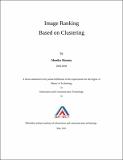Image ranking based on clustering
Abstract
In a typical content-based image retrieval (CBIR) system, query results are a set of images sorted
by feature similarities with respect to the query. However, images with high feature similarities to the query may be very different from the query. We introduced a novel scheme to rank images, cluster based image ranking, which tackle this difference in query image and retrieved images based on hypothesis: semantically similar images tends to clustered in same cluster. Clustering approach attempts to capture the difference in query and retrieved images by learning the way that similar images belongs to same cluster. For clustering color moments based clustering approach is used. The moment is the weighted average intensity of pixels. The proposed method is to compute color Moments of separated R,G,B components of images as a feature to get information of the image. This information can be used further in its detail
analysis or decision making systems by classification techniques. The moments define a
relationship of that pixel with its neighbors. The set of moments computed will be feature vector
of that image. After obtaining the feature vector of images, k-means classification technique is
used to classify these vectors in k number of classes. Initial assignment of data to the cluster is not random, it is based on maximum connected components of images. The two types of features are used to cluster the images namely: block median based clustering and color moment based clustering. Experiments are performed using these features to analyze their effect on results. To demonstrate the effectiveness of the proposed method, a test database from retrieval result of LIRE search engine is used and result of Lire is used as base line. The results conclude that the proposed methods probably give better result than Lire result. All the
experiments have been performed on in MATLAB(R). Wang database of 10000 images is used for retrieval. It can be downloaded from http://wang.ist.psu.edu/iwang/test1.tar
Collections
- M Tech Dissertations [923]

